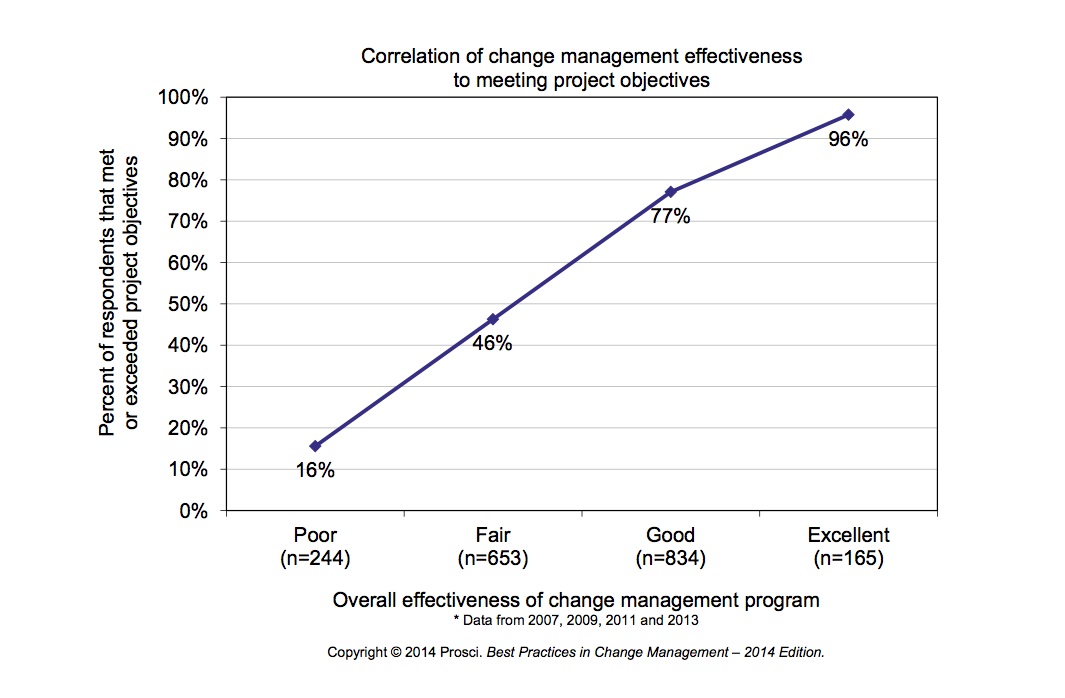
The statistics on failed change efforts are scary. Huge amounts of time and money lost, let alone the potential value of the change not being recognised. Often, these results are the function of key people with the organisation not understanding what is change management, and why it is so critical to any change effort.
Why bother with understanding what is change management?
The key reason for understanding what is change management, is that without this understanding, projects fail.
Failed projects cost organisations money and time.
In the McKinsey Quarterly article “Helping Employees Embrace Change”, the authors examined 40 projects. Specifically, they were looking at:
- ROI expected
- ROI delivered
- Level of change management effectiveness
They found that there was a direct correlation between change management effectiveness and the gap between ROI expected and ROI delivered. Importantly:
- Those that were above average on all three factors realised 143% of the expected value; and
- Those that were below on all three factors realised 35% of the expected value.
These figures are reiterated over and over again. As an example, a recent study by Towers Watson in 2013 found that only 25% of change management initiatives were successful over the long term.
25%!!
You wouldn’t usually take those odds with any other business decision; and yet, time and time again, organisations enter into change efforts (whether that is M&A activity, introducing a new system such as SAP or introducing cultural change) that realistically, according to all the studies have a 75% chance of failure.
And we’re not talking about small amounts of cash for these change efforts. Usually we are talking millions, quite often significantly more. So, it is a bit unusual that this thing called change management is not more widely understood.
So what is change management?
Until recently, people thought of change management as a function of project management. It would perhaps have a few lines in the gantt chart, usually around how to communicate the change. But change management is quite different and distinct from project management.
Prosci defines change management as: “the process, tools and techniques to manage the people side of change to achieve the required business results.“
Why the people side of change? Well, as we’ve talked about before, organisations don’t change, it is the people within them that change.
Notice that there is nothing here about being warm and fuzzy. We do this thing called change management because it achieves results; business results.
Back to Prosci again. They define the success of a project or change by measuring the: speed of adoption, ultimate utilisation (participation) and the proficiency of the users/participants.
Successful change happens when you get people doing what you want them to do, quickly, correctly and efficiently. We have all heard the stories of a multi million dollar SAP implementations where the accountants have their own work around excel spreadsheets. And this week I heard of an organisation implementing the same ERP system again (at huge cost of time and money) because it didn’t “take” the first time around.
It pays to understand this stuff, and to get it right.
How will understanding change management make a difference?
Why should we understand what is change management? And more importantly, implement it when there is change afoot?
The chart below is most telling. Respondents to the survey said that when there was good change management, the project met or exceeded its objectives. And when there was poor change management (or no change management), the project objectives were not met.

Want to meet your business objectives and achieve a ROI on your project or change? Of course you do. I have never met an organisation or MD who goes into a change expecting or wanting to fail.
Then the answer is very simple; start by understanding what is change management and how it fits with your change or project. And then, critically, introduce a change management approach in concert with your project management. And watch your chances of success soar.
Until next week, happy reading.

Ps. Did you read last week’s blog on how to successfully overcome resistance to change in organisations?

